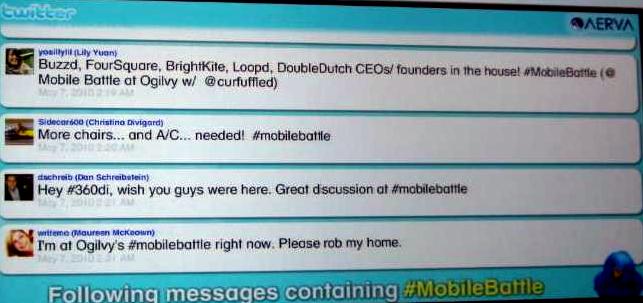The unspoken conversations we should be having with video walls
by Shane Schick — Apr 15 '14
by Shane Schick — Apr 15 '14

I go to so many conferences, and have now seen them set up so often, that I barely notice the social media screen any more.
This may be less common at academic gatherings, but at events in the technology industry you can now reliably count on the organizers setting up a giant monitor somewhere on site that shows a running feed of all the comments from attendees on Twitter. Usually these are organized by the hashtag that identifies the event. There’s usually little attempt to filter or highlight anything that gets displayed on the screen. It’s as though, after realizing people were not putting away their smartphones and would be providing a running commentary about their experience online, conference producers want to show that they are aware and encouraging of the practice. The monitor, like the buzz of conversation at the networking cocktail reception near the end of a conference, is a way of showing that the whole thing was a big success.
To me, though, Twitter walls at events are a huge missed opportunity, and show how far we still have to go to integrating display technology in a way that’s more effective and sustainable. What gets tweeted during the keynote speeches, plenary sessions and coffee breaks represent an incredible source of data on what resonated with attendees. Instead of capturing and studying it, event producers tend to simply turn off the monitor at the end of the day and rely on people filling out that same paper-based evaluation forms they’ve been using for decades. They fail to recognize that what’s being said on social media is a parallel but distinct event in its own right. It should be a place where experts engage, contribute and provide additional value to what’s being said on stage.
This isn’t just a failing of the conference industry. Instead of a monitor, why aren’t more people implementing software to power actual digital signs which would not be limited to a day or multi-day event but permanently installed in helpful locations within an organization? Examples might be the lobby of a public space where visitors could get a sense of what’s going on inside or tweet questions about what they need upon arrival. Retailers could offer information about products and services right next to a shelf, and curate links to videos, articles and other content that help shoppers get more out of what they’re preparing to buy. There are plenty of startups with good products that could offer some degree of this today, including Tint, SocialWally and TweetBeam, but I suspect there’s also still lots of room to innovate here.
So much of what you see in digital signage is basically a one-way conversation between who owns the sign and those that happen to glance in its direction. There are still untold ways that the silent but never-ending dialogue taking place on social channels could be harnessed, curated and amplified to completely rethink the user experience of being in a particular location. It’s time to pay more attention to the enormous panel discussion that happens long before — and long after — any kind of isolated conference or event takes place.
Shane Schick is the editor of CommerceLab. A writer, editor and speaker who helps people create value with information technology. Shane is also a technology columnist with Yahoo Canada, an editor-at-large with IT World Canada, the editor of Allstream’s expertIP online community and the editor of a U.S. magazine about mobile apps called FierceDeveloper. Shane regularly speaks to CIOs and IT managers at events across Canada about how they can contribute to organizational success, and comments on technology trends as a guest on CBC, BNN, CTV and other programs.
Twitter LinkedIn Google+
Apr 17 '14

Apr 16 '14

Apr 15 '14

Apr 11 '14
Copyright © 2016 CommerceLab


